As the year ends, I am sending out some odds and ends that have been accumulating in my Hot Stove folder. My editor Rita says it reads like I’m cleaning out my closet. She is very perceptive.
Nerd Alert: For those of you in the “general” audience, feel free to skip the nerd-heavy stats and scroll down to the Statistics-Free Zone – Judging the Royals and Lonnie’s Jukebox.
Warm Thoughts While It’s Cold Outside: Royals pitchers and catchers report to spring training on February 13, just 46 days away. Five days later, the rest of the roster reports. The first spring training game is on February 24 in Surprise against the Dodgers. Opening Day at Kauffman Stadium is on March 29 against the White Sox. This will be the Royals 50th season.
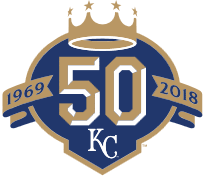
True Hot Stove Time: We will be hearing a lot about how rebuilding the Royals will lead to some losing seasons. There will be many opinions on the moves made (and not made) by Dayton Moore. And yes, it’s more fun to win, but each year 29 teams don’t win the World Series. However no need to be pessimistic – there is always a big world of baseball trivia, nostalgia and projections to keep us engaged as we sit around the virtual Hot Stove this offseason. As journalist and sometimes baseball philosopher George Will has said:
“CORRECT THINKERS THINK THAT ‘BASEBALL TRIVIA’ IS AN OXYMORON; NOTHING ABOUT BASEBALL IS TRIVIAL.”
He is mostly right, and I will share some non-trivial trivia below. Good trivia is of course in the eye of the beholder, and there is some trivia we could do without. Like junk statistics. Details to follow.
Looking Back – Some 2017 Royals Trivia: Eric Hosmer, Lorenzo Cain and Mike Moustakas had pretty good (likely final) seasons for the Royals. But Moose was the one who kept us tuning in as he chased Steve Balboni’s team record for home runs (36 in 1985). For us old-timers, we were also watching to see if Moose would break the KC major league record of 38 set by Bob Cerv with the Kansas City A’s in 1958. On September 20, Moose hit #37 in Toronto to break the Royals record. He finished with 38 to tie Cerv for the all-time KC record.
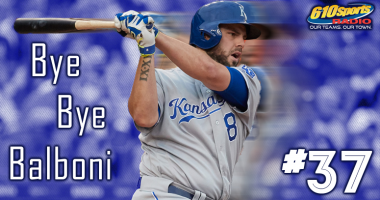
The night before Moose hit #37, Alex Gordon also broke a season record for home runs. When he led off in the top of the 8th in Toronto on September 19, there had been 5,693 homers hit so far in the major leagues in 2017. After working a full count, Alex hit it out of the park for homer number 5,694, breaking the prior record set in 2000. There is also irony in baseball. When Alex hit the record breaking homer, he had the lowest slugging percentage in the league. The final tally for the season was 6,105.
The 1916 New York Giants hold the record for consecutive wins – 26. There was some question if the Giants streak was tainted because there was a tie after the first 12 games of the streak, but the Giants won the following day in the makeup game for the tie. The 1935 Chicago Cubs were next in line with a 21-game streak. On September 14, the Cleveland Indians passed up the Cubs by getting to number 22 with a win over the Royals. But the next night, the Royals won to become the first team in 101 years to break a team’s winning streak of 22 games or longer. [See Junk Statistics below]
The Giants and Indians streaks highlight one of the very cool things about baseball: we readily compare teams and players over a large arc of time. Or as more eloquently described by sportswriter Joe Posnanski:
“And that 1916 Giants’ 26-game streak is the longest winning streak in baseball history. It absolutely should be in the record books. The tie doesn’t nullify it. The fact that they were all home games doesn’t nullify it. The fact that they were playing in a segregated time, and every game was a day game, and the slider had not been invented yet, and spitballs were legal, and the ball was mushy, and the gloves were pillows, and everybody made a billion errors, and 12 home runs led the National League and hitters averaged a .632 OPS and so on – none of this nullifies this streak. Why don’t those things nullify the streak? Because we’re baseball fans, and we don’t want that streak nullified. We prefer to believe. The wish many of us have as baseball fans is to keep the game ageless, eternal, to celebrate yesterday and today as if they are the same thing.”
The Royals had a streak of their own. As they started their game against Tampa Bay on August 29, they had gone 43 innings without scoring a run. The record of 48 was held by the 1906 A’s and 1968 Cubs. The streak moved to 45 after two innings, but Whit Merrifield hit a homer in the third to end the Royals futility.
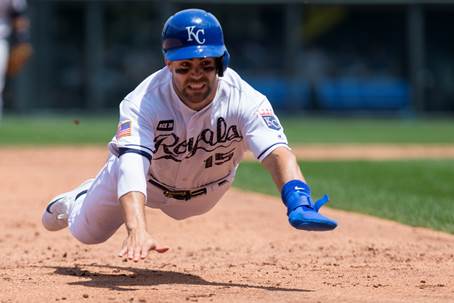
Whit Merrifield
Whit also excelled at stealing bases and led the American League with 34. He is the fifth Royal to lead the league, joining Amos Otis (1971), Fred Patek (1977), Willie Wilson (1979) and Johnny Damon (2000).
On September 25, the Royals played a rainout makeup game at Yankee Stadium. Entering the game, Aaron Judge had 48 homers, one behind Mark McGwire’s rookie record. Judge hit homers in the 3rd and 7th to tie and then break McGwire’s record.
Looking Forward – Projections for 2018: The Bad News: According to ZIPS (ESPN Insider), the Royals will finish 69-93 in 2018, dead last in MLB. FanGraphs says 66-96, next to last. Have not yet seen a 2018 PECOTA number.
Maybe Good News: As a reminder, the Cubs were 66-96 in 2013. They won the World Series three years later. The Astros were 51-111 in 2013. They won the World Series four years later.
Maybe More Good News: The Royals consistently do better than projected. PECOTA, the projection arm of Baseball Prospectus, has undervalued the Royals for eight straight years. In the two World Series years, PECOTA missed by 10 games (2014) and 23 games (2015). Last year, PECOTA projected 71 wins for the Royals. They finished 80-82.
Seriously Bad News: Remember when the Royals were ranked at the top for their minor league system? It was one of Dayton Moore’s goals when he arrived in Kansas City. It started well. In his first draft in 2007, he selected Mike Moustakas, Danny Duffy and Greg Holland. In 2008, Eric Hosmer. In 2009, it was Wil Myers who was later traded for Wade Davis and James Shields. Two second basemen were drafted in 2010: Christian Colon in the first round; his eventual replacement Whit Merrifield in the ninth. At one stage, the Royals had nine prospects in Baseball America’s Top 100, six in the Top 20.
But now the Royals have almost no “top prospects” as listed by the pundits. From 2011 to date, the players taken by the Royals in the regular draft have a cumulative WAR that is the third worst in the majors. Last year, stat guru Keith Law (more on him below) ranked the Royals farm system at #23. Bleacher Report put them at #29. The pipeline needs restocking and better drafting – that’s what rebuilding is all about. Stay tuned.
Albert Pujols and Smart Baseball: The best two first basemen ever? Easy. Lou Gehrig and Albert Pujols. Pujols will be playing his 18th season next year, 11 with the Cardinals and what will be his 7th as an Angel. He is a lock as a first-ballot Hall of Famer. In the four years remaining in his back-loaded contract, Pujols will receive another $114 million from the Angels.
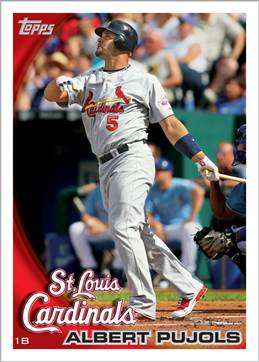
Pujols as a Cardinal
In 2017, Pujols passed the 600 mark in career homers. He knocked in 101 runs. But the headlines on the web were not kind: “Albert Pujols is the worst player in baseball”; “Albert Pujols is on track to the fifth-worst 100 RBI season ever.” What’s going on? Getting more than 100 RBIs was once a stat that meant a player had an excellent season. The new math of baseball does not agree.
A book making the rounds for baseball nerds is Smart Baseball: The Story Behind the Old Stats That Are Ruining the Game, the New Ones That Are Running It, and the Right Way To Think About Baseball. Author Keith Law is a baseball writer and analyst for ESPN, and he makes a compelling case that the stats we grew up with and read beneath the bubblegum residue on baseball cards – like batting average, RBIs and pitching wins – are outdated. He methodically exposes the flaws of such traditional statistics and shows how the new advanced stats are helping teams win, changing how players are valued and altering how we talk about the game.
I’ll again quote that baseball philosopher George Will who reviewed the book:
“Baseball is the sport with the longest season: 162 games before 10 teams play on into October, with two often finishing in early November. As a game of distinct episodes – pitch by pitch, out by out, inning by inning – it generates an ever-richer sediment of data as new technologies yield ever-more refined measurements: spin rates of pitches, ‘tilts’ (angles of breaks) of sliders, launch angles of swings, exit velocities of balls coming off bats, and so on. These new measurements by a new generation of…’quants’…[who] work, not always harmoniously, with their teams’ managers, who are expected to use the data when putting together lineups and making in-game decisions.”
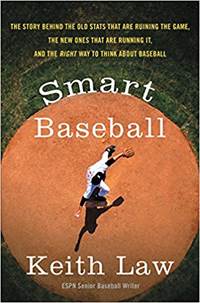
So out with batting average, pitcher wins, RBIs, saves, stolen bases (if caught), fielding percentage and sacrifice bunts. Also, no such thing as clutch hitting. In with OBP, OPS, FIP, WPA, WAR, etc. One traditional statistic holds up fairly well – ERA, but it is also better with some advanced refinements. Confused yet? You’ll just have to read the book.
Albert Pujols is the poster child of how advanced stats do not reward RBIs, which Law calls “Baseball’s Unreliable Narrator.” Law has authoritative support in this 1954 quote from Branch Rickey, “As a statistic, RBIs were not only misleading but dishonest. They depended on managerial control, a hitter’s position in the batting order, park dimensions and the success of his teammates in getting on base ahead of him.”
The low esteem of RBIs is also reflected in WAR, the popular comprehensive stat that is often used in Hall of Fame consideration and salary negotiations. For his 16 seasons before 2017, Pujols had a career WAR of 101.2 (George Brett was 88.4). In 2017, the one with 101 RBIs, Pujols WAR was a NEGATIVE 1.8, reducing his career WAR to 99.4. His RBIs were trumped by lack of speed, hitting into double plays, low on-base percentage, no positive fielding metrics (mostly played DH), etc. My how far the mighty RBI has fallen.
Junk Statistics: No, not RBIs. I’m referring to the oddball and obscure facts we sometimes get from sportswriters and broadcasters. Sportswriter Frank Deford once joked about this kind of stat by referring to the calculation of a player’s “road-game on-base percentage with two outs against southpaws in the 1920s.”
Some of the best (worst?) junk stats are those that show up on stadium scoreboards. The idea seems to be that every player excels in some stat. Say like hitting .300 in games played on Tuesdays. The only left handed hitter to homer to left field in the 3rd inning. Hits .500 on national holidays. Okay, maybe not that bad, but close. My favorite junk stat last year came in a tongue-in-cheek tweet: “Yasiel Puig is the first guy with blue hair to hit a home run in a World Series game.”
Richard Barbieri, a writer for The Hardball Times, attended several Yankee games to gather what he called “weird” scoreboard facts. One example was when Raul Ibanez was at the plate; the scoreboard message was “Raul has hit a home run off 14 different pitchers whose surname ends with the letter ‘Z’.” Below is a similar take for Yunel Escobar. At least there is some worthwhile Yogi Berra trivia.

And something a little different for our own Alcides Escobar.

The next time you are at Kauffman Stadium, keep your eye on the scoreboard for junk stats. Then make fun of them.
Statistics-Free Zone – Judging the Royals: Lee Judge was the political cartoonist for the Kansas City Star from 1981 until two weeks ago. His other gig at the Star since 2010 has been his excellent online baseball column, “Judging the Royals.” Although Lee has left the Star, I am pleased to report that he is continuing his baseball writing at his own website. So keep up with him here. You can also follow him on Twitter to get notices of new posts (@leejudge8).
Lee’s posts are mostly stat-free. As he explains, his purpose is to write about the game from a player’s perspective. “Baseball beat writers have to take an entire game and condense it into one newspaper article. I had the luxury of taking one play and examining everything that went into it. Instead of focusing on results, I got to write about process; how and why things happened the way they did.”
For his column, Lee needed lots of cooperation from players and coaches. In his first season in 2010, he found the perfect way to gain their respect – he went to battle with a pitching machine. This story starts with a column Lee wrote about a Royals player who got out of the way of an inside pitch with the bases loaded in a tie game. After all, it was only an 81-mph slider, and so he wrote “I’d be willing to come down out of the press box and get hit by that pitch if it meant winning a ballgame.”
Famous last words. Lee was working on a story with hitting coach Kevin Seitzer and this included Lee taking some swings in the batting cages. He then had a “much better and stupider” idea – let’s set the pitching machine so I can get hit with an 81-mph slider. Pitching machines are not always precise. Judge got a 92-mph slider square on his left kidney (I am choosing to not show the photo of the bruises). It hurt. A lot. But, “Any admiration I’d won from the ballplayers by getting hit by the pitch would be lost if I fell to the ground and started crying. So I took it like a man and even got off a pretty good bat flip.”
He became somewhat famous. The Royals players were impressed. The video was shown on ESPN and MLB Network. The following year, Eric Hosmer moved up to the big leagues, and he had heard the story. Lee: “The first day Eric Hosmer came to the big leagues I walked over to introduce myself and Eric looked up and said, ‘Are you the guy?’ Yup, I’m the guy. That night Hosmer and I walked out of the stadium together and I expected him to get swamped. We stepped out the stadium doors and a kid walked right past Hosmer and wanted to talk to me about that pitch.”
During Lee’s first year with his column in 2010, catcher Jason Kendall played his only season with the Royals. Kendall retired after the season to end a 15-year major league career. Kendall was a big source for Lee’s posts – by the very nature of their position, catchers know a ton about baseball. Kendall liked that Lee was writing about the small details and said he should write a book. Lee said no, Jason should write a book. So they both did. Together. Throwback was published in 2014. Five stars from me. It will change and enrich the way you watch a ballgame.
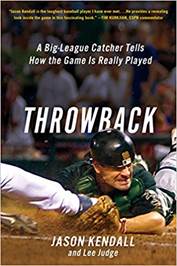
For many years, Lee has raised funds (some $160,000) for Project Warmth by giving originals of his cartoons to contributors. Most of the cartoons reflect his political thoughts, but he occasionally has featured the Royals. Below is a photo of one of his originals that I picked up through his Project Warmth program. As the Royals work on rebuilding, it’s nice to have this nostalgia piece on the miracle of the Royals comeback against Oakland in the 2014 Wild Card Game.
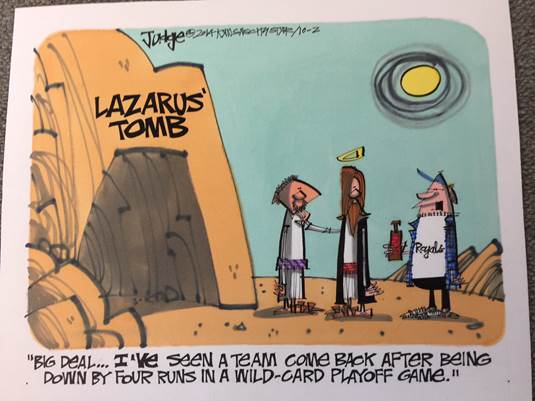
Lonnie’s Jukebox: This space is usually tied to a golden oldie originally played as a 45-rpm vinyl. But today I’m going to substitute a story that ends with a clip that I think will be music to your ears.
In 1957, two players destined for the Hall of Fame were on the roster of the minor league Miami Marlins: 50-year-old Satchel Paige and 25-year-old Whitey Herzog.
Herzog was working his way up the minors which had included a stint with the Kansas City Blues in 1952. He eventually played eight years in the majors, three of those for the Kansas City Athletics from 1958 to 1960. He moved on to an 18-year Hall of Fame managerial career that included 5 seasons with the Royals (1975-1979) and 11 with the Cardinals (1980-1990). His Cards lost to the Royals in the 1985 World Series.
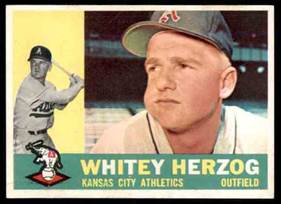
Bill Veeck bought the Miami Marlins in 1956, and one of his first moves was to add Satchel Paige to the roster. Paige had previously pitched for Veeck in the majors at Cleveland (1948-1949) and St. Louis (the Browns, 1951-1953). Veeck introduced Paige to Miami fans on opening night by delivering Satch to the field in a helicopter. The next year, Whitey Herzog joined the Marlins, and Satch nicknamed him “Wild Child.”
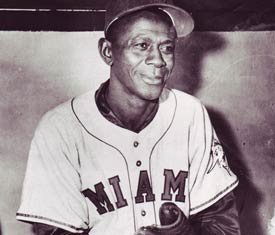
Whitey has a story about his time with Satchel in Miami. I first read about it earlier this month in Larry Tye’s biography on Satchel Paige, and in further checking, I found that Vin Scully has also told the tale in a delightful broadcast in 2015. Vin was broadcasting a Dodgers game against the now major league version of the Miami Marlins. Among the many cool things in the YouTube clip is that the hitter Adrian Gonzalez fouls off enough pitches to give Vin enough time to tell the whole story in one at bat. Please take a listen here (2:58) – as I said, music to your ears.
Suggested Reading: For those who want to dig deeper. The Royals have put together a nice website reflecting Royals history over five decades and the promotions coming up for this golden anniversary year. Click here. The Lee Judge article on his hit-by-pitch is worth a full read and includes video of the fateful pitch.
Suggested Viewing: Big Sonia, a documentary of a Holocaust survivor (now 92) and last tenant at the Metcalf South Shopping Center. It is at the Glenwood Arts, being held over because of good crowds. We are also still promoting four of our favorites from the Telluride Film Festival that are now in theatres: Lady Bird, The Shape of Water, Loving Vincent and Darkest Hour. On TV, we liked The Marvelous Mrs. Maisel (Amazon Prime).
HAPPY NEW YEAR!